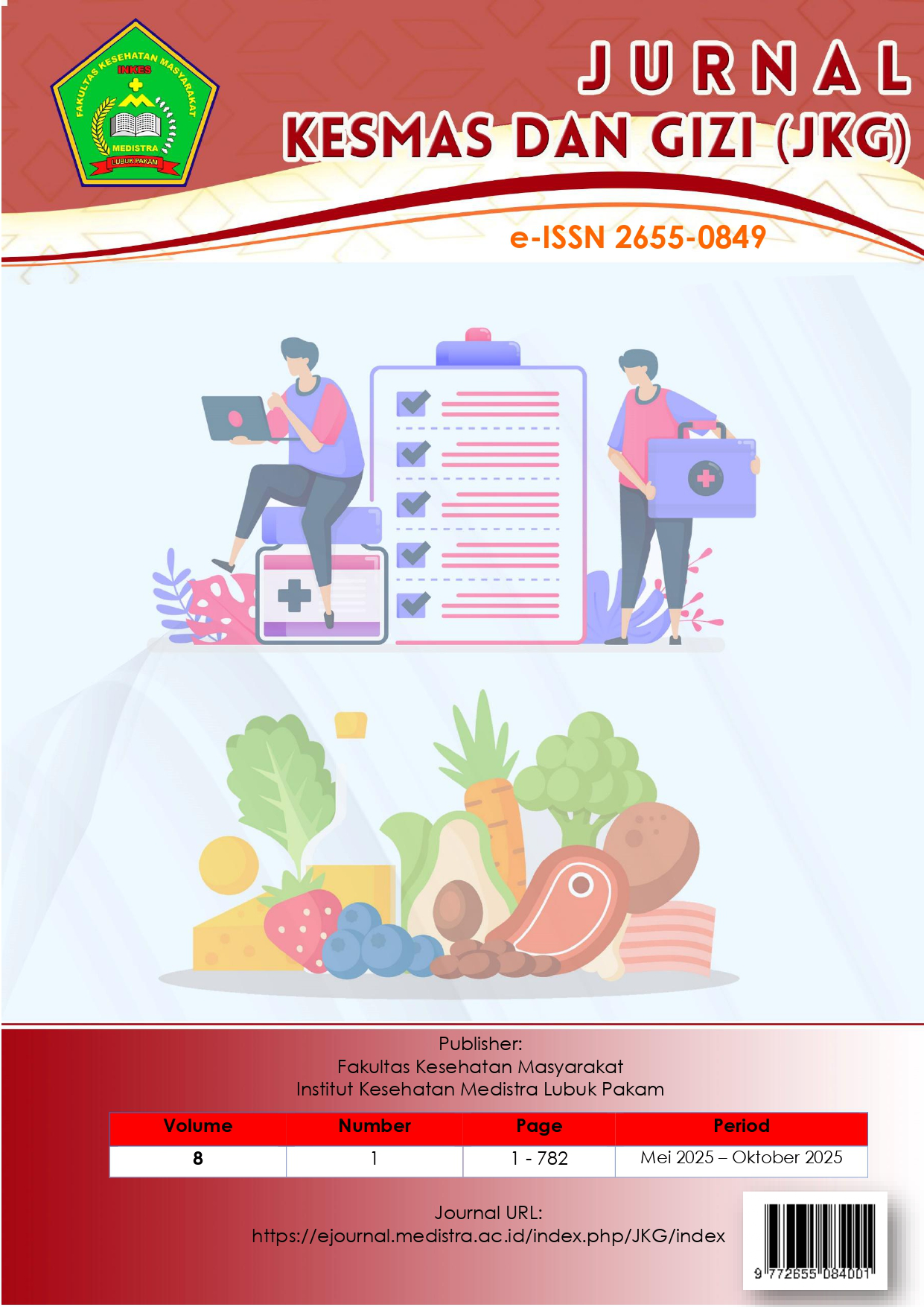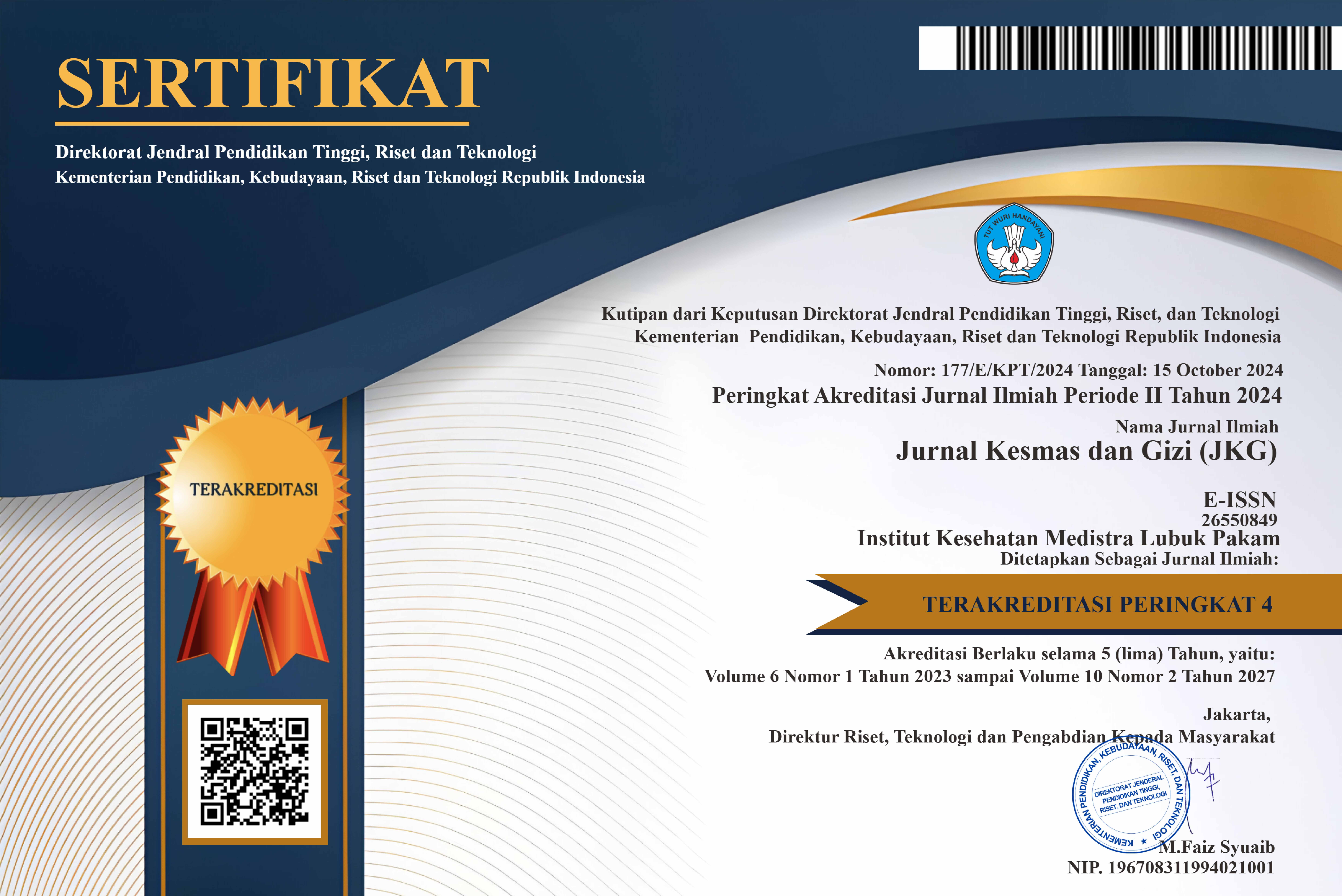Moisture Content and Protein Content of Apem Cake Based on a Composite of Purple Sweet Potato and Corn Flour
DOI:
https://doi.org/10.35451/07hkzs96Keywords:
Apem, Moisture content, Proteint content, Purple sweet potato flour, Corn flourAbstract
Sweet potatoes and corn are local food ingredients with potential as alternative substitutes for rice. Traditionally, apem cakes are made using rice flour as the main ingredient. Partially replacing rice flour with sweet potato flour and corn flour is expected to optimize the utilization of these local ingredients and improve the nutritional value of the resulting apem cake. This study aimed to analyze the effect of using purple sweet potato flour and corn flour on the moisture content and protein content of apem cake. The study employed a completely randomized design (CRD) with four formulations of rice flour, purple sweet potato flour, and corn flour, namely A (100%:0%:0%), B (50%:15%:35%), C (50%:25%:25%), and D (50%:35%:15%). Moisture content was measured using the gravimetric method, while protein content was analyzed using the titrimetric method. Moisture content data were analyzed using Welch’s ANOVA, and protein content was analyzed using One-Way ANOVA followed by Tukey’s HSD test. The results showed that the highest moisture content was 41.42% in the formulation with 15% purple sweet potato flour and 35% corn flour, and the lowest was 40.76% in the 100% rice flour formulation. Welch’s ANOVA indicated no significant difference in moisture content among treatment groups (p = 0.378; p > 0.05). The highest protein content was 4.51% in the 100% rice flour formulation, and the lowest was 4.09% in the formulation with 35% purple sweet potato flour and 15% corn flour. ANOVA results indicated a statistically significant difference in protein content (p = 0.001; p < 0.05). In conclusion, the use of purple sweet potato flour and corn flour in apem cake did not significantly affect moisture content but significantly influenced protein content. Further investigations should focus on optimizing the formulation to evaluate the influence of the treatment on product quality and storage stability.
Downloads
References
[1] E. Nurhayati, Mulyana, V. I. Ekowati, and A. Meilawati, “Inventaris Makanan Tradisional Jawa Serta Alternatif Pengembangannya,” Universitas Negeri Yogyakarta, Yogyakarta, 2013. Accessed: Jun. 30, 2025. [Online]. Available: https://eprints.uny.ac.id/23355/1/artikel%20inventarisasi%20makanan%20tradisional.pdf
[2] N. Hayati, R. Purwanti, and A. Kadir, “Preferensi masyarakat terhadap makanan berbahan baku sagu (Metroxylon Sagu Rottb) sebagai alternatif sumber karbohidrat di Kabupaten Luwu dan Luwu Utara Sulawesi Selatan,” Jurnal Penelitian Sosial dan Ekonomi Kehutanan, vol. 11, no. 1, pp. 82–90, 2014, doi: 10.20886/jpsek.2014.11.1.82-90.
[3] E. Purwati, R. Zumrotul, and F. Z. Rosyada, “Pengembangan Produk Pangan Melalui Bahan Alternatif dan Pengayaan Kandungan Gizi,” J@ti Undip: Jurnal Teknik Industri, vol. 20, no. 1, pp. 21–32, Jan. 2025, doi: https://doi.org/10.14710/jati.20.1.21-32.
[4] C. B. Ndangui, J. Petit, C. Gaiani, J. M. Nzikou, and J. Scher, “Impact of Thermal and Chemical Pretreatments on Physicochemical, Rheological, and Functional Properties of Sweet Potato (Ipomea batatas Lam) Flour,” Food Bioproc Tech, vol. 7, no. 12, pp. 3618–3628, Dec. 2014, doi: 10.1007/s11947-014-1361-3.
[5] I. Fitri, Hotmauli, Nurmaliza, B. D. M. Iballa, and S. Herlina, “Macro and Micronutrients of Purple Sweet Potato Flour as Material Raw Complementary Feeding,” Journal of Advanced Research in Applied Sciences and Engineering Technology, vol. 30, no. 1, pp. 44–49, Mar. 2023, doi: 10.37934/araset.31.1.4449.
[6] V. K. Mugalavai, K. O. Aduol, and A. O. Onkware, “Nutritional Characteristics of Rice (Oryza sativa L.) Composite Flours Obtained by Food Fortification,” European Journal of Agriculture and Food Sciences, vol. 3, no. 1, pp. 79–83, Jan. 2021, doi: 10.24018/ejfood.2021.3.1.224.
[7] M. Afkar, K. Nisah, and H. Sa’diah, “Analisis kadar protein pada tepung jagung, tepung ubi kayu dan tepung labu kuning dengan metode kjedhal,” Amina, vol. 1, no. 3, pp. 108–113, 2020, doi: https://doi.org/10.22373/AMINA.V1I3.46.
[8] X. N. Guo, Y. Jiang, J. J. Xing, and K. X. Zhu, “Effect of ozonated water on physicochemical, microbiological, and textural properties of semi-dried noodles,” J Food Process Preserv, vol. 44, no. 4, p. 1, Apr. 2020, doi: 10.1111/jfpp.14404.
[9] Y. Bao and P. Ertbjerg, “Effects of protein oxidation on the texture and water-holding of meat: a review,” Crit Rev Food Sci Nutr, vol. 59, no. 22, pp. 3564–3578, Dec. 2019, doi: 10.1080/10408398.2018.1498444.
[10] M. H. Rafdi, Supriyanto, and D. Hidayati, “The Effect of Formula and Cooking Temperature on Sereal Characteristics of Purple Sweet Potato and Corn Composite Flour,” JITIPARI, vol. 9, no. 1, pp. 90–100, 2024, doi: https://doi.org/10.33061/jitipari.v9i1.9978.
[11] S. D. Permatasari, V. Melani, and R. Fadhilla, “Studi Pembuatan Roti Dengan Substitusi Tepung Jagung Dan Tepung Ubi Jalar Ungu Sebagai Alternatif Sarapan Rendah Kalori,” Jurnal Ilmu Gizi, vol. 21, no. 4, pp. 90–105, 2018, Accessed: Jun. 30, 2025. [Online]. Available: https://digilib.esaunggul.ac.id/public/UEU-Undergraduate-11039-JURNAL.Image.Marked.pdf
[12] D. Saputro and P. Kurnia, “Pengaruh Penggunaan Tepung Biji Kecipir (Psophocarpus Tetragonolobus L.) Sebagai Substitusi Tepung Beras Dalam Pembuatan Kue Apem Terhadap Kadar Protein Dan Daya Terima,” Universitas Muhammadiyah Surakarta, Surakarta, 2016.
[13] AOAC, Protein (Crude) in Animal Feed, Forage (Plant Tissue), Grain, and Oilseeds. Block Digestion Method Using Copper Catalyst and Steam Distillation into BoricAcid. Washington: Association Analytical Chemist, 2005.
[14] M. S. Tapia, S. M. Alzamora, and J. Chirife, “Effects of Water Activity (a w ) on Microbial Stability: As a Hurdle in Food Preservation,” Water Activity in Foods, pp. 239–271, 2007, doi: https://doi.org/10.1002/9780470376454.ch10.
[15] H. Nawaz, R. Waheed, M. Nawaz, and D. Shahwar, “Physical and Chemical Modifications in Starch Structure and Reactivity,” in Chemical Properties of Starch, IntechOpen, 2020, p. 1. doi: 10.5772/intechopen.88870.
[16] H. Wang, Q. Yang, L. Gao, X. Gong, Y. Qu, and B. Feng, “Functional and physicochemical properties of flours and starches from different tuber crops,” Int J Biol Macromol, vol. 148, pp. 324–332, Apr. 2020, doi: 10.1016/j.ijbiomac.2020.01.146.
[17] J. K. Yu and Y. S. Moon, “Corn starch: Quality and quantity improvement for industrial uses,” Plants, vol. 11, no. 1, pp. 1–9, Jan. 2022, doi: 10.3390/plants11010092.
[18] Susiyanti, Rusmana, Y. Maryani, Sjaifuddin, N. Krisdianto, and M. A. Syabana, “The physicochemical properties of several Indonesian rice varieties,” Biotropia (Bogor), vol. 27, no. 1, pp. 41–50, 2020, doi: 10.11598/btb.2020.27.1.1030.
[19] A. S. M. Fageer and A. H. El Tinay, “Effect of genotype, malt pretreatment and cooking on in vitro protein digestibility and protein fractions of corn,” Food Chem, vol. 84, no. 4, pp. 613–619, 2004, doi: 10.1016/S0308-8146(03)00286-3.
[20] N. da S. Timm, G. H. Lang, A. H. Ramos, R. S. Pohndorf, C. D. Ferreira, and M. de Oliveira, “Effects of drying methods and temperatures on protein, pasting, and thermal properties of white floury corn,” J Food Process Preserv, vol. 44, no. 10, p. 1, Oct. 2020, doi: 10.1111/jfpp.14767.
[21] Y. Zhang et al., “Physicochemical properties and protein structure of extruded corn gluten meal: Implication of temperature,” Food Chem, vol. 399, p. 133985, 2023, doi: https://doi.org/10.1016/j.foodchem.2022.133985.
[22] B. Hernández-Santos, A. A. Lerdo-Reyes, J. Rodríguez-Miranda, and T. J, “Chemical composition, techno-functional properties, and bioactive components of blends of blue corn/purple sweet potato for its possible application in the food industry,” Food Measure, no. 17, pp. 1909–1920, 2022, doi: https://doi.org/10.1007/s11694-022-01767-7.
Downloads
Published
Issue
Section
License
Copyright (c) 2025 Fatimah Azzahrah, Pramudya Kurnia, STP., M.Agr, Sudrajah Warajati Kisnawaty, S.Gz., M.Gz

This work is licensed under a Creative Commons Attribution 4.0 International License.
Copyright in each article is the property of the Author.


























